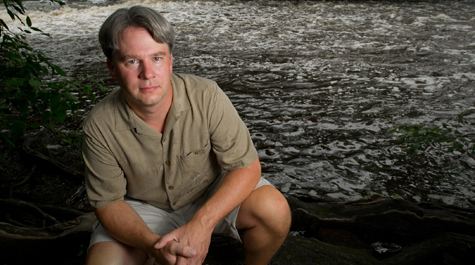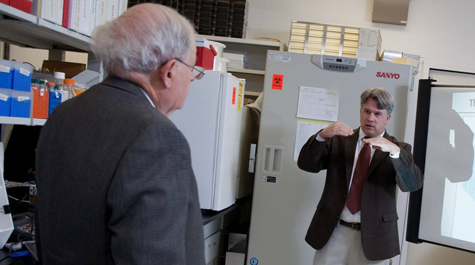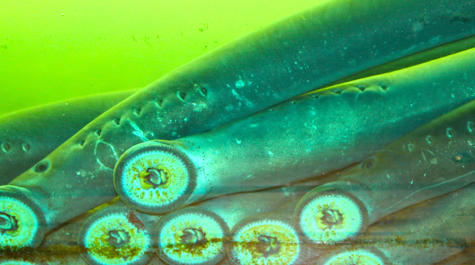Researchers use lamprey’s sense of smell to aid control effort
VIMS alum at forefront of efforts to protect native fishes from parasite
Dr. Michael Wagner, Assistant Professor at Michigan State University, is researching and developing methods to control one of the most destructive invasive species in the Great Lakes—the sea lamprey.
Wagner, who received his Master’s degree from the Virginia Institute of Marine Science in 1997, is a behavioral ecologist in MSU’s Department of Fisheries and Wildlife. He has been studying the sea lamprey Petromyzon marinus for more than eight years, focusing on how scientists can use the fish’s exquisite sense of smell to aid in control efforts.
A recent interview on National Public Radio highlighted Wagner’s latest advance in sea lamprey research—discovery of chemical compounds released by dead and decaying lampreys that may help resource managers to manipulate and control living fish during their spawning migration.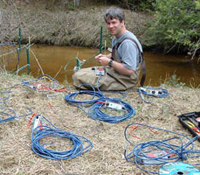
Lampreys—also known as “swimming noses”—rely on smell throughout their complex life cycle, which in addition to a parasitic adult form includes several years as a larva burrowed into river-bottom muds. “Sea lampreys are most active at night, and every critical decision they make is mediated by odor,” says Wagner.
Native to the western Atlantic Ocean—including Chesapeake Bay and other East Coast waterways—sea lampreys use their sucker-like mouth and sharp teeth to attach and feed on the bodily fluids of large-bodied fishes, often scarring and killing their host. They invaded the Great Lakes through manmade ship canals beginning in the 1920s.
“When the population exploded in the early 20th century,” says Wagner, “it devastated Great Lakes fisheries stocks, including several of the fishes we rely on like lake trout.”
In response, the United States and Canada established the Great Lakes Fisheries Commission, which has had significant success in reducing the lamprey threat through continuing application of a pesticide. Government agencies apply the pesticide annually in rivers where larvae are present, thus killing the lamprey before they reach adulthood.
“The Commission was able to reduce the lamprey population to 10 percent of what it had been, but pesticides are expensive and sometimes cause inadvertent harm to other species. The Commission approached us to see if there was anything we could do to help,” says Wagner.
Prior work by Wagner and colleagues focused on synthesizing and applying pheromones that larvae and adult males naturally release to lure females into suitable upstream spawning habitats. Wagner says “These pheromones have proven to be powerful attractants when applied to stream water, and we've expended considerable effort to identify novel ways to exploit this communication system to control lamprey populations.”
Wagner’s recent work turns the tables on this earlier research, investigating ways to repel spawning adults using his discovery and identification of chemical compounds released during the decay of dead lampreys.
“When migrating the sea lamprey relies on these odors to tell them where to go, and where not to go,” says Wagner. “They work like traffic lights at the intersections between rivers. The odor of thriving larvae indicates the presence of good habitat for spawning. The death odor alerts a migrant to the risk of predation, or the recent death of older larvae. If we manipulate the odors, we may be able to control where they end up.”
By releasing both repellants and attractants at carefully selected river junctions—what’s known as a “push-pull approach”—Wagner thinks resource managers can funnel spawning adults into the tributary of their choice, helping to concentrate control efforts. 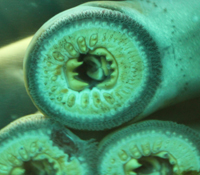
“Because successful blockage at any point in a river network protects all areas upstream, a large fraction of the watershed may be blocked off with applications at a few sites, greatly limiting the amount of spawning area available and reducing the area in need of subsequent pesticide treatment,” he says.
“This Unite-and-Conquer approach to controlling the invasive species will allow agencies like the Commission to save money and be more effective,” adds Wagner. “By driving the lampreys into areas where the pesticide may be safely applied, we protect the Great Lakes ecosystem as well as meet the demand for lamprey control.”
In other areas of the world, particularly Europe, lampreys are considered a delicacy rather than a pest. They were even served at Queen Elizabeth’s 60th coronation anniversary.
“Europe is interested in the restoration of the species, while we’re interested in their destruction,” says Wagner. “Luckily, the research we’re doing will inform both sides of the spectrum because both rely on trying to manipulate the lamprey to move where you need them to go. In Europe, they’re looking for an area for the lamprey to thrive.”
Wagner focused on community ecology while completing his Master’s in William & Mary’s School of Marine Science at VIMS. He went on to earn his doctorate at the University of Georgia before he heard about the job opening in Michigan.
“I knew fishes and behavior,” says Wagner. “But I had never worked on sea lamprey, never worked on the Great Lakes, and never worked on the topic of chemical communication. The best thing about a career in science is the constant challenge and the thought of doing something new.”


